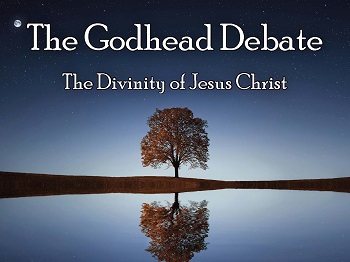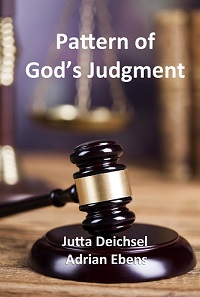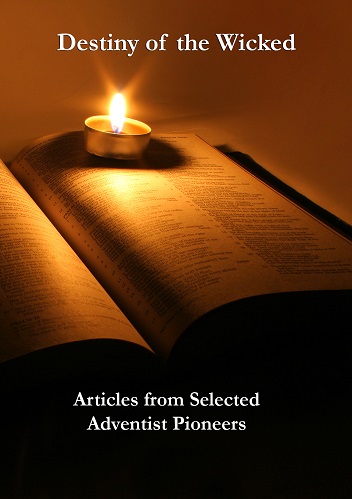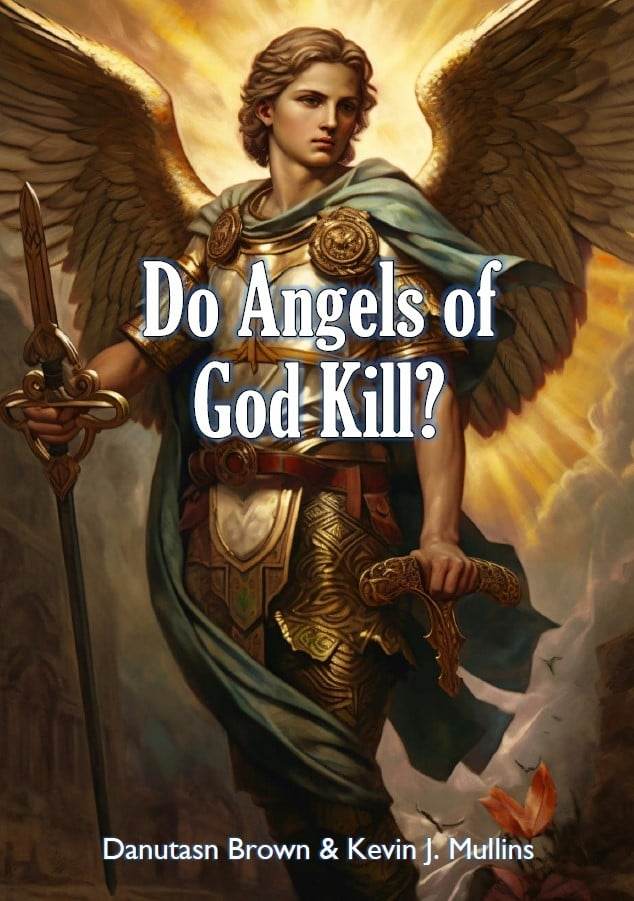The Two Birds
We are reconciled to God by the death of His Son.
How much more are we saved by the life of His Son!
This thought, expressed by Paul in Romans 5:10, encompasses the two personalities, the two natures, the two agencies of the divine Son of God.
He is both our Sacrifice and our Priest;
our Saviour and our Intercessor;
the Lamb and the Advocate;
our Redeemer and our Comforter.
He died for us that he might live in us.
He took our weakness that he might give us his strength.
This dual function of Christ as Flesh and Spirit, body and mind, was taught by the sacrifice and sending forth of the two birds in Leviticus 14. This was a special ceremonial practice performed when leprosy was healed, when a leper was cleansed of his disease, a symbol of sin. It involved life and death, a baptism and a release from bondage to freedom.
Baptism is a ceremonial practice enjoined on the followers of Christ who repent of their sins, who die to their old life of sin, who are buried in a watery grave, and resurrected to a new life in Christ—and Christ in us! Let us learn the lesson of the two birds.
“If the plague of leprosy be healed in the leper; then shall the priest command to take for him that is to be cleansed two birds alive and clean, and cedar wood, and scarlet, and hyssop: and the priest shall command that one of the birds be killed in an earthen vessel over running water: as for the living bird, he shall take it, and the cedar wood, and the scarlet, and the hyssop, and shall dip them and the living bird in the blood of the bird that was killed over the running water. And he shall sprinkle upon him that is to be cleansed from the leprosy seven times and shall pronounce him clean, and shall let the living bird loose into the open field.” Leviticus 14:2-7
The two birds must at first be “alive and clean.” They have life and they are clean, spotless, without blemish, free of sin and sickness.
“The wonderful symbol of the living bird dipped in the blood of the bird slain and then set free to its joyous life (Lev. 14:4-8), is to us the symbol of the atonement.” Sons and Daughters of God, p. 226, 1BC p.1111.
Jesus came as the Son of God and became the Son of man. He who was an immortal Spirit, took on mortal flesh, that he might give his life. He who was without sin, bore our sins, that he might give his righteousness. In him was life, eternal life.
The priest then takes cedar, and scarlet, and hyssop. Cedar is a symbol of the incorruptible nature of Christ’s divinity; scarlet is a symbol of blood that is shed; “Without the shedding of blood there is no remission of sin” hyssop is a symbol of the power to cleanse and remove sin. “Purge me with hyssop and I shall be clean” Ps 51:7.
“There were death and life blended, presenting to the searcher for truth and hidden treasure, the union of the pardoning blood with the resurrection and life of our Redeemer. The bird slain was over living water; that flowing stream was a symbol of the ever flowing, ever cleansing efficacy of the blood of Christ, the Lamb slain from the foundation of the world...” Ibid.
This theme of cleansing and purging is discussed by Paul in Hebrews 9.
“For if the blood of bulls and of goats and the ashes of a heifer sprinkling the unclean, sanctifies to the purifying of the Flesh:” Heb 9:13
“How much more shall the blood of Christ, who through the eternal Spirit offered himself without spot to God, purge your conscience from dead works to serve the living God?” Heb 9:14.
In these two verses, Paul is contrasting the effectiveness of the two covenants: “the blood of bulls” in the First Covenant of the Old Testament with “the blood of Christ” in the New Testament; “the unclean” body with “dead works” in our “conscience;” and “Flesh” with “Spirit.”
The literal Greek text is:
to haima tou Xristou hos dia pneumatos aiōniou heauton prosēnegken amōmon tō theō
the blood of-the Christ who thru spirit ageless himself offered spotless to the God
This text illustrates a common observation: “spirit” frequently occurs without the definite article in Greek yet is translated into English as if it did (Acts 6:3, 5: 7:55; 8:15, 17, 19: 9:17;
11:24; 13:9, 52; 19:2; Rom 9:1; 14:17; 15:13, 16, 19; 1Cor 12:3; Heb 2:4; 6:4; 2Pet 1:21; Jude 20). The Jamieson-Fausset-Brown Bible Commentary recognizes this and associates this usage of “spirit” in rendering the passage to mean that Christ offered his blood through “His divine Spirit (Rom 1:4, in contrast to His "flesh," Heb 9:3; His Godhead, 1Tim 3:16; 1Pet 3:18), "His inner personality" [Alford], which gave a free consent to the act.”
In the First Covenant the blood of animals purified the Flesh through sprinkling by a priest. In the New Covenant the blood of Christ purges the conscience through the Spirit of Christ.
“the eternal Spirit” in Heb 9:14 parallels “that eternal Life” in 1John 1:2.
Both come from the Father and both are in the Son.
1John 5:20 is a recapitulation of John’s introduction in 1:2.
“We know that the Son of God is come, and has given us an understanding, that we may know Him that is true, and we are in Him that is true, in His Son Jesus Christ. This is the true God, and eternal life.”
The Father-Son motif continues in this epistle to the very end. The Son of God has given us understanding about the Father, “that we may know Him that is true.” Who this? Jesus identified Him in his pray in John 17:3. “This is eternal life that they might know Thee, the only true God and Jesus Christ whom Thou hast sent.” Him that is true is the only true God, the Father. This is the true God. Jesus Christ is the eternal life that God has sent. Jesus is “that eternal life which was with the Father and was manifested unto us” 1John 1:2.
A superficial reading of 1John 5:20 has led some to hastily conclude that “His Son Jesus Christ is the true God” by assuming the “This” refers to Jesus instead of Him that is true. But John ends his epistle with the same pair of personalities with which he begins the letter: the Father and the Son. “Truly our fellowship is with the Father, and with His Son Jesus Christ” 1John 1:3. Just as he pairs “the Word” with “the God” in John 1:1, so here he features “that eternal life” with “the Father” in verse 2. So also he ends with the same pair: “the true God” (the Father) and that “eternal life” (the Son).
The living bird never died or saw corruption. It is eternal. But it is baptized as the other bird is slain. The living bird represents the perfect sinless life Spirit that the Son of God gave into the Father’s hands. Jesus was baptized as part of his sacrificial death, just as the living bird is dipped into the blood tinged water before being released. Jesus asked James and John, “Are you willing to be baptized with the baptism that I am baptized with?” Matt 20:22. He was not only baptized in the Jordan, but he was also baptized on Golgatha. “Yet learned he obedience by the things which he suffered; and being made perfect, he became the author of eternal salvation” Heb 5:8,9.
When Christ was crucified, a Roman soldier pierced his side and out flowed water and blood.
Jesus said, those who drink of his blood would receive a stream of living water flowing out of his belly (John 7:38). This stream is a cleansing stream, the cleansing, regenerating power of his own Spirit. “In that day there shall be a fountain opened to the house of David and to the inhabitants of Jerusalem for sin and for uncleanness…and they shall look upon me whom they have pierced and they shall mourn for him, as one mourns for his only son…for his first-born.” Zech 13:1; 12:10.
When Jesus died, his Spirit, his character, his mind was preserved in the Father’s keeping.
Then the promise of the Father could be fulfilled when Jesus ascended on high and gave gifts unto men (Ps 68:18; Eph 4:8) “for the perfecting of the saints” Eph 4:12. He sends his omnipresent Spirit to live in the temples of his trusting children.
“The plant, the child, grows by receiving from its surroundings that which ministers to its life —air, sunshine, and food. What these gifts of nature are to animal and plant, such is Christ to those who trust in Him. He [Christ] is their “everlasting light,” “a sun and shield.” Isaiah 60:19; Psalm 84:11. He [Christ] shall be as “the dew unto Israel.” “He [Christ] shall come down like rain upon the mown grass.” Hosea 14:5; Psalm 72:6. He [Christ] is the living water, “the Bread of God . . . which cometh down from heaven, and giveth life unto the world.” John 6:33. Steps to Christ, pp. 67, 68
The living bird, baptized with the baptism with which the slain bird is baptized, is set free “into the open field.” When Jesus was glorified in heaven after his ascension, the Father “sent forth
the Spirit of His Son into your hearts” Gal 4:6. The Spirit belongs to Jesus; it is his Spirit.
The Lamb stands before the Father’s throne in Revelation 4 with seven horns (all power, omnipotence) and seven eyes (all knowing, omnipotence). These are identified as “the seven Spirits of God sent forth into all the earth” Rev 4:6. Why is his Spirit sent?
“that your sins may be blotted out when the times of refreshing shall come from the presence of the Lord; And he [God the Father] shall send Jesus Christ” Acts 3:19,20.
He was sending Jesus in another form, as another Comforter to his children.
“The Comforter…whom the Father will send in my name” John 14:26
“The Comforter…whom I will send unto you from the Father” John 15:26
“The Comforter…I will send him unto you” John 16:7
“I will not leave you comfortless, I will come to you” John 14:18.




